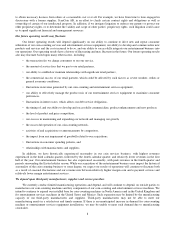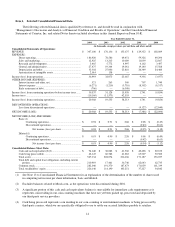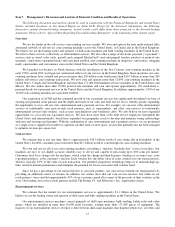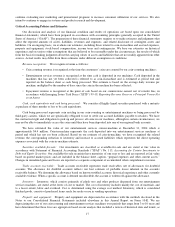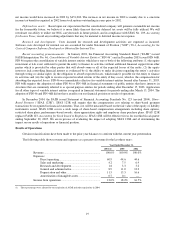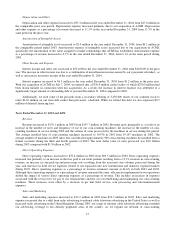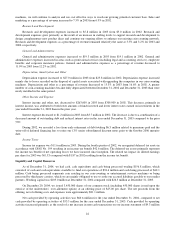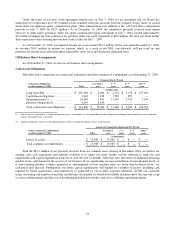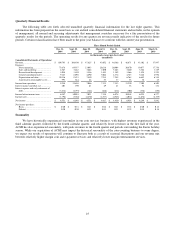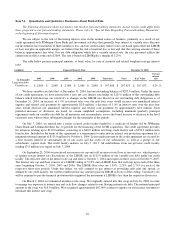Redbox 2004 Annual Report Download - page 22
Download and view the complete annual report
Please find page 22 of the 2004 Redbox annual report below. You can navigate through the pages in the report by either clicking on the pages listed below, or by using the keyword search tool below to find specific information within the annual report.18
well as other relevant factors. We will continue to evaluate the useful life of our coin-counting and entertainment services
machines, as well as our other property and equipment as necessary, and will determine the need to make changes when and
if appropriate. Any changes to the estimated lives of our machines may cause actual results to differ based on different
assumptions or conditions.
Purchase price allocations: In connection with our acquisitions of our e-payment subsidiaries and ACMI, we have
allocated the respective purchase prices plus transaction costs to the estimated fair values of assets acquired and liabilities
assumed. These purchase price allocation estimates were based on our estimates of fair values and estimates from third-party
consultants.
Goodwill and intangible assets: Goodwill represents the excess of cost over the estimated fair value of net assets
acquired, primarily from our recent acquisition of ACMI in July 2004, which in accordance with SFAS No. 142, Goodwill
and Other Intangible Assets, is not being amortized. Also in accordance with SFAS No. 142, we test goodwill for impairment
at the reporting unit level on an annual basis or as determined necessary. SFAS No. 142 requires a two-step goodwill
impairment test whereby the first step, used to identify potential impairment, compares the fair value of a reporting unit with
its carrying amount including goodwill. If the fair value of a reporting unit exceeds its carrying amount, goodwill of the
reporting unit is considered not impaired and the second test is not performed. The second step of the impairment test is
performed when required and compares the implied fair value of the reporting unit goodwill with the carrying amount of that
goodwill. If the carrying amount of the reporting unit goodwill exceeds the implied fair value of that goodwill, an impairment
loss shall be recognized in an amount equal to that excess. Based on the annual goodwill test for impairment we performed
during the quarter ended December 31, 2004, we determined there is no impairment of our goodwill.
Our intangible assets are comprised primarily of retailer relationships acquired in connection with our recent
acquisition of ACMI in July 2004 and two other smaller acquisitions during 2004. A third-party consultant used expectations
of future cash flows to estimate the fair value of the acquired retailer relationships. We amortize our intangible assets over
their expected useful lives, which range from 3 to 10 years.
Impairment of long-lived assets: Long-lived assets, such as property and equipment and purchased intangibles subject
to amortization, are reviewed for impairment whenever events or changes in circumstances indicate that the carrying amount
of an asset may not be recoverable. Recoverability of assets to be held and used is measured by a comparison of the carrying
amount of an asset group to the estimated undiscounted future cash flows expected to be generated by the asset group. If the
carrying amount of an asset group exceeds its estimated future cash flows, an impairment charge is recognized in the amount
by which the carrying amount of the asset group exceeds the fair value of the asset group.
Fees paid to retailers: Fees paid to retailers relate to the amount we pay our retail partners for the benefit of placing
our machines in their stores and their agreement to provide certain services on our behalf to our customers. The fee is
calculated as a percentage of each coin-counting transaction or as a percentage of our entertainment and vending revenue and
is recorded in our income statement under the caption “direct operating expenses.” The fee arrangements are based on our
evaluation of certain factors with the retailers such as total revenue, e-payment capabilities, long-term non-cancelable
contracts, installation of our machines in high traffic and/or urban or rural locations, new product commitments, co-op
marketing incentive or other criteria. We recognize this expense at the time we recognize the associated revenue from each of
our customer transactions. This expense is recorded on a straight-line basis as a percentage of revenue based on estimated
annual volumes.
Fair value of financial instruments: The carrying amounts for cash and cash equivalents approximate fair value,
which is the amount for which the instrument could be exchanged in a current transaction between willing parties. The fair
value of our term and revolving loans approximates their carrying amounts. Our interest rate derivative is carried at fair
value.
Foreign currency translation: The functional currency of our International subsidiary is the British Pound Sterling.
We translate assets and liabilities related to these operations to U.S. dollars at the exchange rate in effect at the date of the
consolidated balance sheet; we convert revenues and expenses into U.S. dollars using the average monthly exchange rates.
Translation gains and losses are reported as a separate component of accumulated other comprehensive income.
Stock-based compensation: We have several stock-based compensation programs which are described more fully in
the Notes to our Consolidated Financial Statements included elsewhere in this Annual Report on Form 10-K. We account for
stock-based awards to employees using the intrinsic value method in accordance with Accounting Principles Board (“APB”)
Opinion No. 25, Accounting for Stock Issued to Employees. If we had determined compensation cost for our stock-based
compensation consistent with the method prescribed in SFAS No. 123, Accounting for Stock-Based Compensation, our net
income would have decreased by $4.8 million in 2004, our net income would have decreased by $5.0 million in 2003 and our


